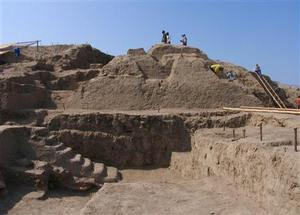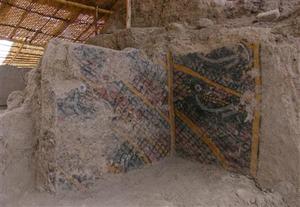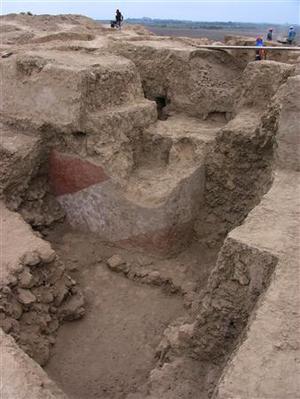
|
| ©REUTERS/Ignacio Alva/Handout |
| Archaeologists work at the clay temple Ventarron in the northern city of Lambayeque, November 10, 2007. |
The temple, inside a larger ruin, includes a staircase that leads up to an altar used for fire worship at a site scientists have called Ventarron, said Peruvian archaeologist Walter Alva, who led the dig.
It sits in the Lambayeque valley, near the ancient Sipan complex that Alva unearthed in the 1980s. Ventarron was built long before Sipan, about 2,000 years before Christ, he said.
"It's a temple that is about 4,000 years old," Alva, director of the Museum Tumbas Reales (Royal Tombs) of Sipan, told Reuters by telephone after announcing the results of carbon dating at a ceremony north of Lima sponsored by Peru's government.

|
| ©REUTERS/Ignacio Alva/Handout |
| A mural is seen on a wall of a clay temple in the northern city of Lambayeque, November 10, 2007. |
"What's surprising are the construction methods, the architectural design and most of all the existence of murals that could be the oldest in the Americas," he said.
Lambayeque is 472 miles from Lima, Peru's capital.
Discoveries at Sipan, an administrative and religious center of the Moche culture, have included a gold-filled tomb built 1,700 years ago for a pre-Incan king.
Peru is rich in archaeological treasures, including the Inca citadel of Machu Picchu in the Andes.

|
| ©REUTERS/Ignacio Alva/Handout |
| A painted wall is seen at the clay temple Ventarron in the northern city of Lambayeque, November 10, 2007. |
Until the arrival of the Spanish in the 1500s, the Incas ruled an empire for several centuries that stretched from Colombia and Ecuador in the north to what are now Peru and Chile in the south.
"The discovery of this temple reveals evidence suggesting the region of Lambayeque was one of great cultural exchange between the Pacific coast and the rest of Peru," said Alva.
(Writing by Terry Wade; Editing by Peter Cooney)



Reader Comments
to our Newsletter